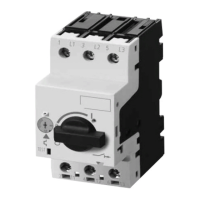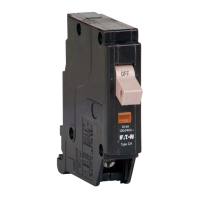I.B. 32-255-1G
Page 23
Effective 12/02
At current zero, the arc is extinguished and vapor produc-
tion ceases. Very rapid dispersion, cooling, recombina-
tion, and deionization of the metal vapor plasma, together
with the fast condensation of metal vapor products, cause
the vacuum to be quickly restored. Hence, the opened
contacts withstand the transient recovery voltage.
5-2.2 CONTACT EROSION INDICATION
The purpose of a contact erosion indicator is to monitor
the erosion of the vacuum interrupter contacts, which is
very minimal over time with vacuum interrupters utilizing
copper-chrome contact material. If contact erosion
reaches 1/8 inch, the interrupter must be replaced. A
green contact erosion indicator mark is located on the
moving stem of the interrupter (Figures 6-2 and 6-3).
In order to determine if the contacts have eroded to the
extent that the interrupter must be replaced, observe the
erosion mark placed on each moving stem from the rear
of the breaker with the breaker closed. The interrupter is
satisfactory if the mark on the stem is visible with the
breaker closed. The entire interrupter assembly must be
replaced if the mark is no longer visible.
5-2.3 LOADING SPRING INDICATOR
The loading spring indicator is an additional method pro-
vided to indicate conditions within the interrupter. The
indicator is used to indicate whether the contact springs
are maintaining the adequate contact pressure to keep
the contacts closed. Severe contact erosion would result
in an unacceptable indication from the indicator (Figure
6-4). Depending upon the structural design, a small
mirror may be required to inspect all three poles.
Note that the actual configuration and/or appearance of
the indicator can vary from one circuit breaker rating to
another. The actual appearance of the indicator
depends upon the color of the contact springs in a spe-
cific circuit breaker. When making this inspection, first
observe the color of the contact springs to determine
how the indicator will appear. Figure 6-4 illustrates what
the actual indicator appearance will be, depending upon
the color of the springs.
5-2.4 CONTACT WIPE AND STROKE
Contact wipe is the indication of (1) the force holding the
vacuum interrupter contacts closed and (2) the energy
available to hammer the contacts open with sufficient
speed for interruption.
Stroke is the gap between fixed and moving contacts of
a vacuum interrupter with the circuit breaker open.
The circuit breaker mechanism provides a fixed amount
of motion to the operating rods. The first portion of the
motion is used to close the contacts (i.e. stroke) and the
remainder is used to further compress the preloaded
wipe spring. This additional compression is called wipe.
Wipe and Stroke are thus related to each other. As the
stroke increases due to the erosion of contacts, the wipe
decreases. A great deal of effort has been spent in the
design of all VCP-W vacuum circuit breakers in order to
eliminate the need for field adjustments of wipe or stroke.
THERE IS NO PROVISION FOR IN-SERVICE
ADJUSTMENTS OF CONTACT WIPE AND STROKE.
ALL SUCH ADJUSTMENTS ARE FACTORY SET
AND SHOULD NOT BE ATTEMPTED IN THE FIELD.
5-2.5 PHASE BARRIERS
Phase barriers on all VCP-W circuit breakers are made
of glass polyester. Table 5.1 gives the number and con-
figuration of the barriers required for each circuit breaker
rating.

